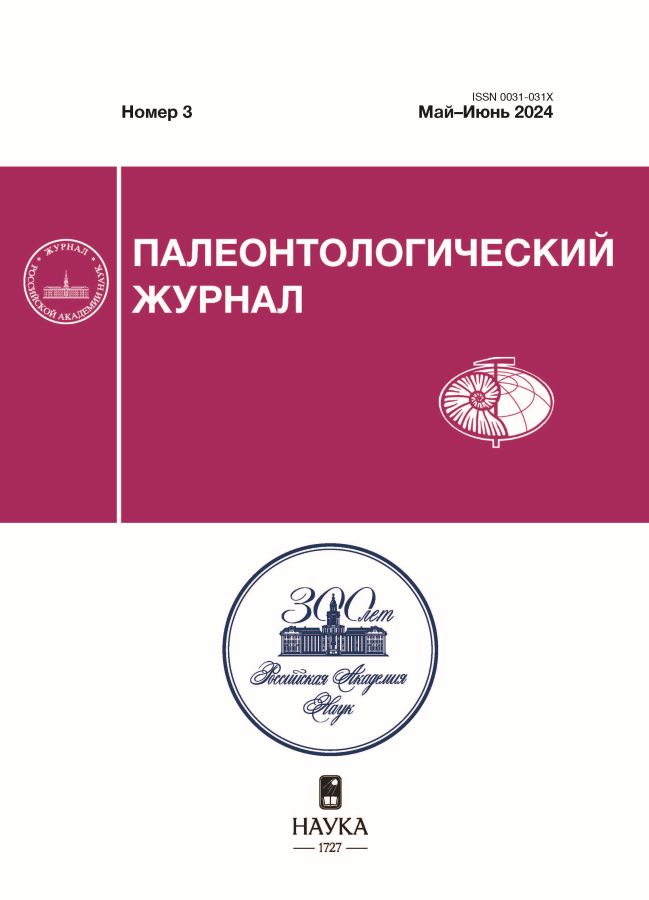А New Species of the Genus Lekiskochiton (Mollusca, Polyplacophora) from the Lower Permian Reef Limestones of Shakhtau (Southern Cisuralia)
- 作者: Mazaev A.V.1
-
隶属关系:
- Borissiak Paleontological Institute, Russian Academy of Sciences
- 期: 编号 3 (2024)
- 页面: 16-27
- 栏目: Articles
- URL: https://clinpractice.ru/0031-031X/article/view/681280
- DOI: https://doi.org/10.31857/S0031031X24030035
- EDN: https://elibrary.ru/EPPURR
- ID: 681280
如何引用文章
详细
A new Early Permian Shakhtau reef dwelling lepidopleurid chiton is described as Lekiskochiton crassus sp. nov. This is one of the few Late Paleozoic chitons described in Russia and the first from the Cisuralia. The new species is represented by the tail valve and four intermedial valves belonging to one large animals, which was found in the reef carbonates of the Asselian Stage. Other scattered valves of a new species were found in younger sediments of this reef massif, in the Sakmara Stage. All of them are preserved as imprints. The shape of the valves has been partially reconstructed. The morphological differences in the intermedial plates of one individual of the genus are shown for the first time. L. crassus sp. nov. is the second species of the genus, which was previously reliably known only from the Middle Permian of Texas by the type species only. The discovery of a new species increases the time range of existence of the genus approximately on 19 million years. In the Shakhtau polyplacophoran assemblage, in addition to the genus Lekiskochiton, the following genera have been previously identified: Gryphochiton, Ochmazochiton and Pterochiton, which indicates stable biogeographical connections of the Early Permian Ural Strait with the sea basins of North America.
全文:
作者简介
A. Mazaev
Borissiak Paleontological Institute, Russian Academy of Sciences
编辑信件的主要联系方式.
Email: mazaev.av@mail.ru
俄罗斯联邦, Moscow, 117647
参考
- Барсков И.С., Морозов П.Е. Хитон (Mollusca, Polyplacophora) из верхнего карбона Подмосковья // Палеонтол. журн. 1996. № 4. С. 3–6.
- Бяков А.С., Мазаев А.В. Первые находки древнейших устрицеподобных двустворчатых моллюсков рода Prospondylus Zimmermann (Pectinida, Prospondylidae) в нижней перми Южного Приуралья (Россия) // Палеонтол. журн. 2023. № 3. С. 42–51.
- Королюк И.К. Методы и результаты изучения пермского рифогенного массива Шахтау (Башкирское Приуралье). М.: Наука, 1985. 111 с.
- Eichwald E. d’. Lethaea Rossica ou Paleontologie de la Russie. V. 1. Sec. 3. Stuttgart, 1860. 1093 p.
- Hoare R.D., Plas L.P., Yancey T.E. Permian Polyplacophra (Mollusca) from Nevada, Utah, and Arizona // J. Paleontol. 2002. V. 76. № 2. Р. 256–264.
- Hoare R.D., Smith A.G. Permian Polyplacophora (Mollusca) from West Texas // J. Paleontol. 1984. V. 58. № 1. P. 82–103.
- Kirkby J.W. On the Permian Chitonidae // Quart. J. Geol. Soc. London. 1859. V. 15. P. 607–626.
- Kjrkby J.W., Young J. Notes on some remains of Chiton and Chitonellus from the Carboniferous strata of Yorkshire and the west of Scotland // Geol. Mag. 1867. V. 4. № 38. P. 340–343.
- Mazaev A.V. Lower Permian gastropods of Shakhtau (Asselian–Sakmarian boundary beds, southern Cisuralia) // Paleontol. J. 2019. V. 53. № 12. P. 1237–1345.
- Schwabe E. Illustrated summary of chiton terminology (Mollusca, Polyplacophora) // Spixiana. 2010. V. 33. № 2. P. 171–194.
- Sirenko B. New outlook on the system of chitons (Mollusca: Polyplacophora) // Venus. 2006. V. 65. № 1–2. p. 27–49.
- Smith A.G. Hoare R.D. Paleozoic Polyplacophora: a checklist and bibliography // Occas. Pap. California Acad. Sci. 1987. № 146. 71 p.
补充文件















